Norway has committed to a 40% reduction of greenhouse gas emissions from the non-ETS sectors by 2030. Transport makes up a major share of Norwegian emissions in the non-ETS. Although there will be flexibility available for the non-ETS sector across the EU members, the Norwegian Parliament has announced that they aim for radical domestic emission cuts in transport.
Norwegian transport can be divided into sea, air, rail and road. Road can further be divided into private, light duty and heavy duty vehicles. The sustainability of transport can be improved by i) reducing the total amount of traveling, ii) modal shift, e.g. from road to rail, and iii) by introducing new technologies (e.g., electric vehicles). For policy it is important to obtain the right balance between the measures; taking into account that there may be market imperfections when introducing new technologies.
Flagship II focuses on four major themes:
1. Electrification of private road transport
- What is the most efficient way to increase the share of plug-in hybrid electric vehicles (PHEV) and/or battery electric vehicles (BEV) in the Norwegian car fleet?
- How have the different incentive mechanisms for PHEVs and BEVs like free parking, free charging, and access to bus lanes, worked with respect to increase the PHEV and BEV market shares?
- What determines the right balance between PHEV/BEV usage and public transport, and how can this mix be achieved? What are the potential costs of incompatibility between charging systems?
2. Integrating transport with electricity markets
- What kind of problems may arise in electricity supply as the share of the car fleet requiring charging on the road increases towards 50%?
- How can BEV owners be motivated and incentivized to provide back-up power capacity when their car is not in use?
- How does the market share of BEVs affect the value of a smart grid?
3. Over-coming barriers to more sustainable commercial transport
- What types of technological, behavioral and infrastructure barriers exist for low- or zero-emission technology in commercial road transport?
- How can firms be motivated and incentivized to adopt zero- or low-emission light and heavy duty vehicles?
- One proposal has been to create a CO2-fund to finance low emission technology for light and heavy duty vehicles – what are the benefits and drawbacks of such a solution?
- What is the potential for emission reductions in national sea transport, including the fishing fleet?
- Is there a future role for hydrogen, and should the government actively support its introduction?
4. Biofuels in road and air transport
- What is the optimal policy mix of biofuels; should storage of organic carbon receive subsidies, should those who burn organic carbon be taxed, and should biofuels technologies for transport purposes be subsidized?
- Which of the politically feasible second-best policies come closest to the first best?
- Is the proposal by the Norwegian Parliament to increase the blending of biofuels in gasoline and diesel to 20 percent by 2020 a good idea?
- To what extent should Norwegian consumption of biofuels be covered by Norwegian forestry resources?


